Abstract
Ninety patients with duodenal ulcer, divided randomly into three groups, were treated continuously for one year with either glycopyrronium, 1-hyoscyamine (as a sustained-release preparation) or inert tablets. Dosage with active tablets was so adjusted that the patient experienced definite but tolerable side-effects. Basal and maximal gastric acid secretion were measured immediately before and one week after cessation of treatment. There was no significant change in the means of these measurements in patients who received placebo or 1-hyoscyamine. In those given glycopyrronium, mean basal output was significantly increased. Mean maximal acid output in this group fell, but not significantly.
Individual measurements of maximal acid output showed quite marked fluctuations in all groups. It is concluded that spontaneous changes in parietal cell mass may occur in patients with duodenal ulcer, and that prolonged anticholinergic therapy does not reduce parietal cell mass.
Full text
PDF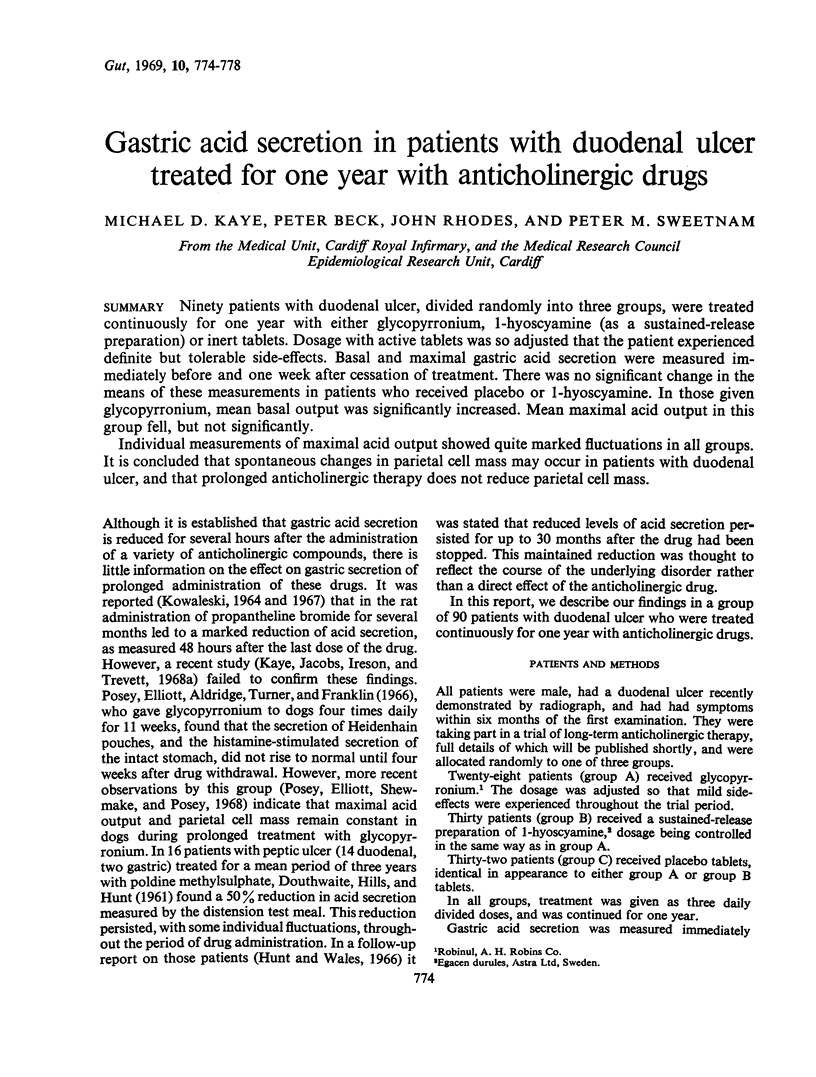
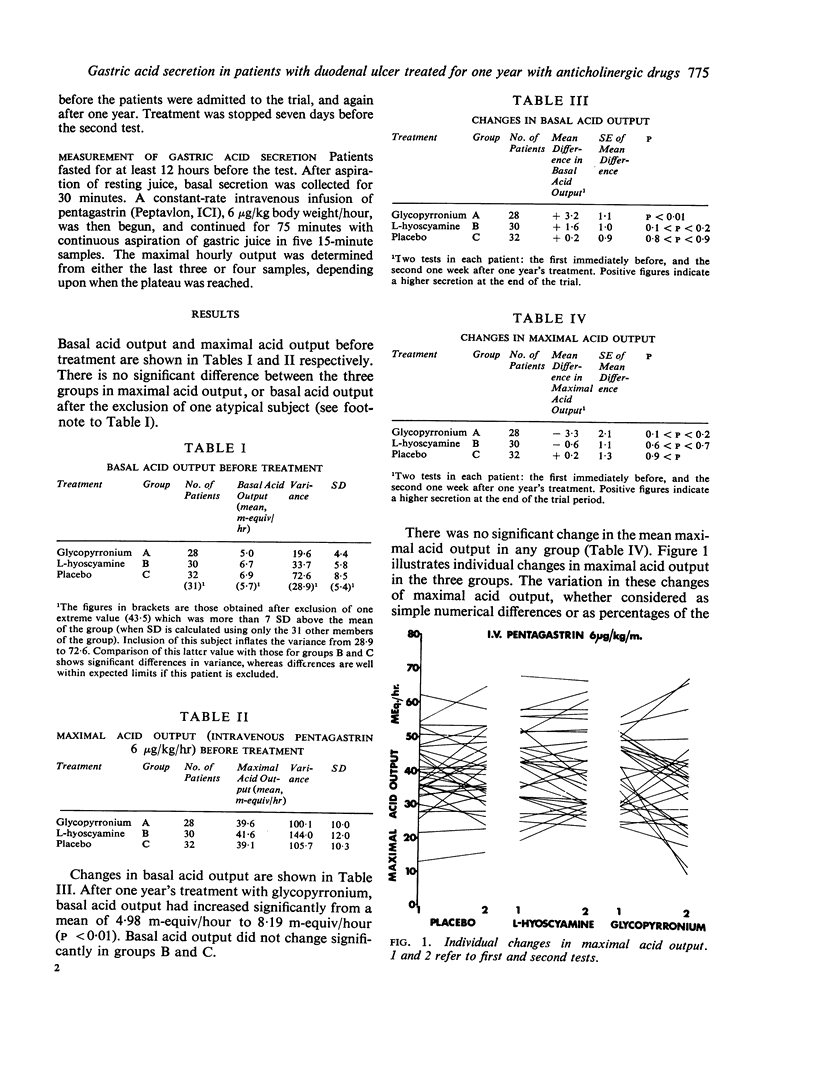
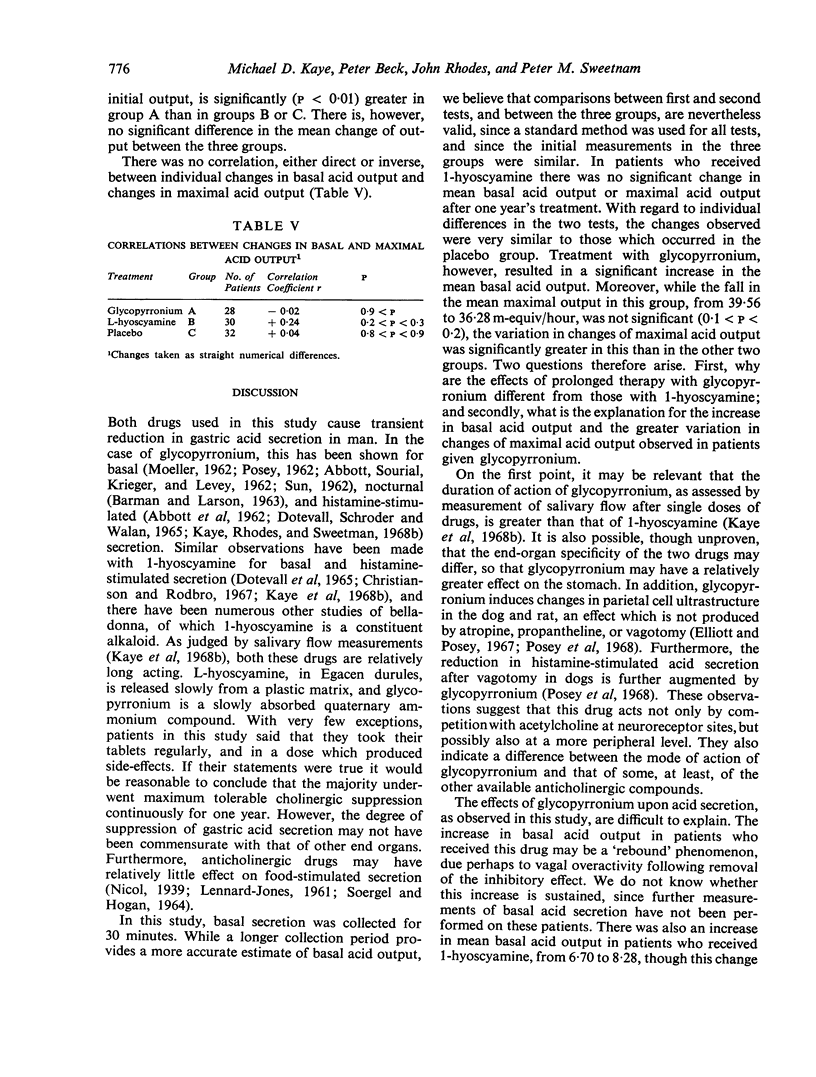
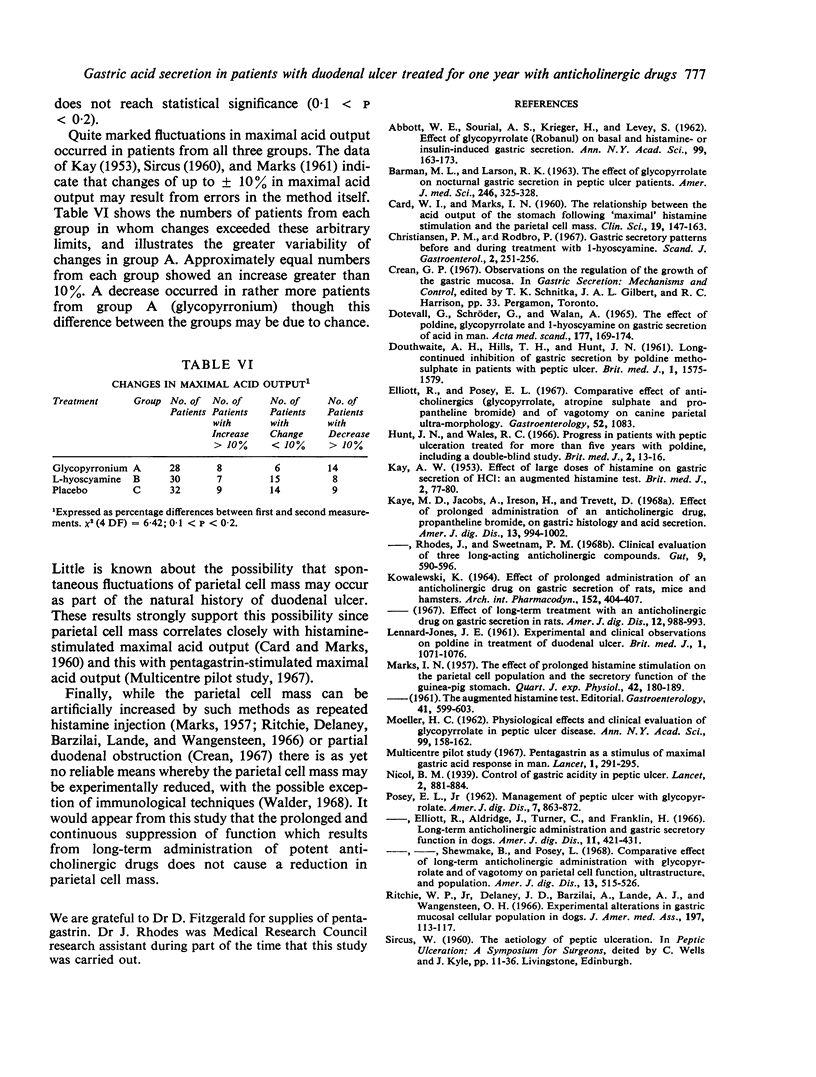
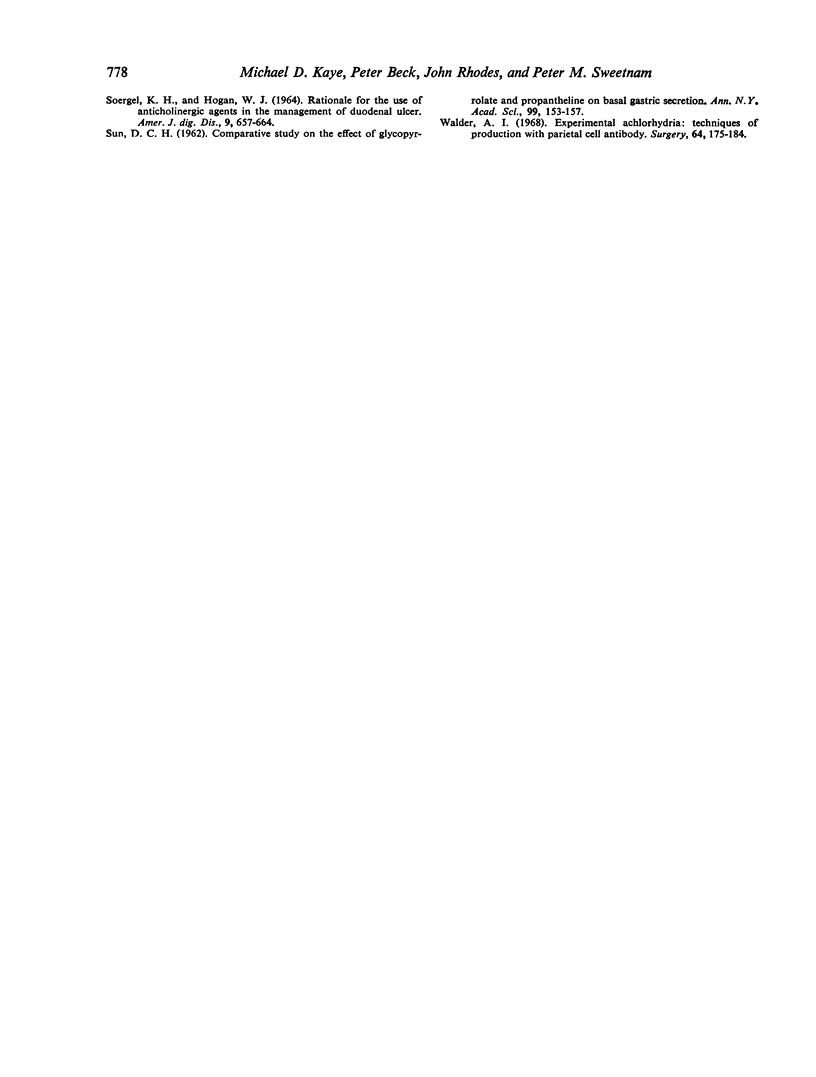
Selected References
These references are in PubMed. This may not be the complete list of references from this article.
- ABBOTT W. E., SOURIAL A. S., KRIEGER H., LEVEY S. Effect of glycopyrrolate (Robanul) on basal and histamine- or insulin-induced gastric secretion. Ann N Y Acad Sci. 1962 Feb 28;99:163–173. doi: 10.1111/j.1749-6632.1962.tb45300.x. [DOI] [PubMed] [Google Scholar]
- BARMAN M. L., LARSON R. K. THE EFFECT OF GLYCOPYRROLATE ON NOCTURNAL GASTRIC SECRETION IN PEPTIC ULCER PATIENTS. Am J Med Sci. 1963 Sep;246:325–328. doi: 10.1097/00000441-196309000-00011. [DOI] [PubMed] [Google Scholar]
- CARD W. I., MARKS I. N. The relationship between the acid output of the stomach following "maximal" histamine stimulation and the parietal cell mass. Clin Sci. 1960 Feb;19:147–163. [PubMed] [Google Scholar]
- Christiansen P. M., Rodbro P. Gastric secretory patterns before and during treatment with 1-hyoscyamine. Scand J Gastroenterol. 1967;2(4):251–256. doi: 10.3109/00365526709180077. [DOI] [PubMed] [Google Scholar]
- DOTEVALL G., SCHROEDER G., WALAN A. THE EFFECT OF POLDINE, GLYCOPYRROLATE AND 1-HYOSCYAMINE ON GASTRIC SECRETION OF ACID IN MAN. Acta Med Scand. 1965 Feb;177:169–174. doi: 10.1111/j.0954-6820.1965.tb01819.x. [DOI] [PubMed] [Google Scholar]
- DOUTHWAITE A. H., HILLS T. H., HUNT J. N. Long-continued inhibition of gastric secretion by poldine methosulphate in patients with peptic ulcer. Br Med J. 1961 Jun 3;1(5239):1575–1579. doi: 10.1136/bmj.1.5239.1575. [DOI] [PMC free article] [PubMed] [Google Scholar]
- KAY A. W. Effect of large doses of histamine on gastric secretion of HCI; an augmented histamine test. Br Med J. 1953 Jul 11;2(4827):77–80. doi: 10.1136/bmj.2.4827.77. [DOI] [PMC free article] [PubMed] [Google Scholar]
- KOWALEWSKI K. EFFECT OF PROLONGED ADMINISTRATION OF AN ANTICHOLINERGIC DRUG ON GASTRIC SECRETION OF RATS, MICE AND HAMSTERS. Arch Int Pharmacodyn Ther. 1964 Dec 1;152:404–407. [PubMed] [Google Scholar]
- Kaye M. D., Jacobs A., Ireson H., Trevett D. Effect of prolonged administration of an anticholinergic drug, propantheline bromide, on gastric histology and acid secretion. Am J Dig Dis. 1968 Nov;13(11):995–1002. doi: 10.1007/BF02232922. [DOI] [PubMed] [Google Scholar]
- Kaye M. D., Rhodes J., Sweetnam P. M. Clinical evaluation of three long-acting anticholinergic compounds. Gut. 1968 Oct;9(5):590–596. doi: 10.1136/gut.9.5.590. [DOI] [PMC free article] [PubMed] [Google Scholar]
- LENNARD-JONES J. E. Experimental and clinical observations of poldine in treatment of duodenal ulcer. Br Med J. 1961 Apr 15;1(5232):1071–1076. doi: 10.1136/bmj.1.5232.1071. [DOI] [PMC free article] [PubMed] [Google Scholar]
- MARKS I. N. The effect of prolonged histamine stimulation on the parietal cell population and the secretory function of the guineapig stomach. Q J Exp Physiol Cogn Med Sci. 1957 Apr;42(2):180–189. doi: 10.1113/expphysiol.1957.sp001249. [DOI] [PubMed] [Google Scholar]
- MOELLER H. C. Physiological effects and clinical evaluation of glycopyrrolate in peptic ulcer disease. Ann N Y Acad Sci. 1962 Feb 28;99:158–162. doi: 10.1111/j.1749-6632.1962.tb45299.x. [DOI] [PubMed] [Google Scholar]
- POSEY E. L., Jr Management of peptic ulcer with glycopyrrolate. Am J Dig Dis. 1962 Oct;7:863–872. doi: 10.1007/BF02231863. [DOI] [PubMed] [Google Scholar]
- Posey E. L., Jr, Elliott R., Aldridge J., Turner C., Franklin H. Long-term anticholinergic administration and gastric secretory function in dogs. Am J Dig Dis. 1966 Jun;11(6):421–431. doi: 10.1007/BF02233601. [DOI] [PubMed] [Google Scholar]
- Posey E. L., Jr, Elliott R., Shewmake B., Posey L., 3rd Comparative effect of long-term anticholinergic administration with glycopyrrolate and of vagotomy on parietal cell function, ultrastructure, and population. Am J Dig Dis. 1968 Jun;13(6):515–526. doi: 10.1007/BF02233063. [DOI] [PubMed] [Google Scholar]
- Ritchie W. P., Jr, Delaney J. D., Barzilai A., Lande A. J., Wangensteen O. H. Experimental alterations in gastric mucosal cellular population in dogs. JAMA. 1966 Jul 11;197(2):113–117. [PubMed] [Google Scholar]
- SOERGEL K. H., HOGAN W. J. RATIONALE FOR THE USE OF ANTICHOLINERGIC AGENTS IN THE MANAGEMENT OF DUODENAL ULCER. Am J Dig Dis. 1964 Sep;9:657–664. doi: 10.1007/BF02232125. [DOI] [PubMed] [Google Scholar]
- SUN D. C. Comparative study on the effect of glycopyrrolate and propantheline on basal gastric secretion. Ann N Y Acad Sci. 1962 Feb 28;99:153–157. doi: 10.1111/j.1749-6632.1962.tb45298.x. [DOI] [PubMed] [Google Scholar]
- Walder A. I. Experimental achlorhydria: techniques of production with parietal cell antibody. Surgery. 1968 Jul;64(1):175–184. [PubMed] [Google Scholar]


